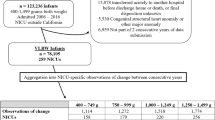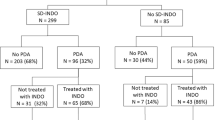Abstract
Objective
The management of early hypotension in extremely low gestational age neonates (ELGANs) varies greatly between centers. The objective of this study was to provide updated data on the use of vasoactive medications in ELGANs during the first postnatal week.
Study design
We identified ELGANs (22–27 weeks gestational age) cared for at Pediatrix neonatal intensive care units from 2009 to 2018. We evaluated the frequency of exposure to vasoactive medications by gestational age, and compared use of vasoactive medications between two epochs (2009–2013 and 2014–2018).
Results
A total of 10,070/34,234 (29%) ELGANs received ≥1 vasoactive medication. Dopamine was the most frequently used vasoactive medication. The majority (83%) of treated ELGANs initiated therapy on postnatal days 0–1. Overall use of vasoactive medications was slightly lower in 2014–2018 than 2009–2013 (28 vs 31%, p < 0.001).
Conclusion
A substantial proportion of ELGANs were exposed to vasoactive medications during the first postnatal week.
This is a preview of subscription content, access via your institution
Access options
Subscribe to this journal
Receive 12 print issues and online access
$259.00 per year
only $21.58 per issue
Buy this article
- Purchase on Springer Link
- Instant access to full article PDF
Prices may be subject to local taxes which are calculated during checkout

Similar content being viewed by others
References
Al-Aweel I, Pursley DM, Rubin LP, Shah B, Weisberger S, Richardson DK. Variations in prevalence of hypotension, hypertension, and vasopressor use in NICUs. J Perinatol. 2001;21:272–8.
Batton B, Batton D, Riggs T. Blood pressure during the first 7 days in premature infants born at postmenstrual age 23 to 25 weeks. Am J Perinatol. 2007;24:107–15.
Fanaroff AA, Fanaroff JM. Short- and long-term consequences of hypotension in ELBW infants. Semin Perinatol. 2006;30:151–5.
Faust K, Hartel C, Preuss M, Rabe H, Roll C, Emeis M, et al. Short-term outcome of very-low-birthweight infants with arterial hypotension in the first 24 h of life. Arch Dis Child Fetal Neonatal Ed. 2015;100:F388–92.
Batton B, Li L, Newman NS, Das A, Watterberg KL, Yoder BA, et al. Use of antihypotensive therapies in extremely preterm infants. Pediatrics. 2013;131:e1865–73.
Dempsey EM, Al Hazzani F, Barrington KJ. Permissive hypotension in the extremely low birthweight infant with signs of good perfusion. Arch Dis Child Fetal Neonatal Ed. 2009;94:F241–44.
Fanaroff JM, Wilson-Costello DE, Newman NS, Montpetite MM, Fanaroff AA. Treated hypotension is associated with neonatal morbidity and hearing loss in extremely low birth weight infants. Pediatrics. 2006;117:1131–5.
Wong J, Shah PS, Yoon EW, Yee W, Lee S, Dow K. Inotrope use among extremely preterm infants in Canadian neonatal intensive care units: variation and outcomes. Am J Perinatol. 2015;32:9–14.
Durrmeyer X, Marchand-Martin L, Porcher R, Gascoin G, Roze JC, Storme L, et al. Abstention or intervention for isolated hypotension in the first 3 days of life in extremely preterm infants: association with short-term outcomes in the EPIPAGE 2 cohort study. Arch Dis Child Fetal Neonatal Ed. 2017;102:490–6.
Batton B, Li L, Newman NS, Das A, Watterberg KL, Yoder BA, et al. Early blood pressure, antihypotensive therapy and outcomes at 18-22 months’ corrected age in extremely preterm infants. Arch Dis Child Fetal Neonatal Ed. 2016;101:F201–6.
Laughon M, Bose C, Allred E, O’Shea TM, Van Marter LJ, Bednarek F, et al. Factors associated with treatment for hypotension in extremely low gestational age newborns during the first postnatal week. Pediatrics. 2007;119:273–80.
Ewer AK, Tyler W, Francis A, Drinkall D, Gardosi JO. Excessive volume expansion and neonatal death in preterm infants born at 27-28 weeks gestation. Paediatr Perinat Epidemiol. 2003;17:180–6.
St Peter D, Gandy C, Hoffman SB. Hypotension and adverse outcomes in prematurity: comparing definitions. Neonatology. 2017;111:228–33.
Verma RP, Dasnadi S, Zhao Y, Chen HH. Complications associated with the current sequential pharmacological management of early postnatal hypotension in extremely premature infants. Proc (Bayl Univ Med Cent). 2019;32:355–60.
Kuint J, Barak M, Morag I, Maayan-Metzger A. Early treated hypotension and outcome in very low birth weight infants. Neonatology. 2009;95:311–6.
Dempsey E, Rabe H. The use of cardiotonic drugs in neonates. Clin Perinatol. 2019;46:273–90.
Noori S, Seri I. Neonatal blood pressure support: the use of inotropes, lusitropes, and other vasopressor agents. Clin Perinatol. 2012;39:221–38.
Rios DR, Kaiser JR. Vasopressin versus dopamine for treatment of hypotension in extremely low birth weight infants: a randomized, blinded pilot study. J Pediatr. 2015;166:850–5.
Baske K, Saini SS, Dutta S, Sundaram V. Epinephrine versus dopamine in neonatal septic shock: a double-blind randomized controlled trial. Eur J Pediatr. 2018;177:1335–42.
Subhedar NV, Shaw NJ. Dopamine versus dobutamine for hypotensive preterm infants. Cochrane Database Syst Rev. 2003;3:CD001242.
Valverde E, Pellicer A, Madero R, Elorza D, Quero J, Cabanas F. Dopamine versus epinephrine for cardiovascular support in low birth weight infants: analysis of systemic effects and neonatal clinical outcomes. Pediatrics. 2006;117:e1213–22.
Osborn D, Evans N, Kluckow M. Randomized trial of dobutamine versus dopamine in preterm infants with low systemic blood flow. J Pediatr. 2002;140:183–91.
Rios DR, Moffett BS, Kaiser JR. Trends in pharmacotherapy for neonatal hypotension. J Pediatr. 2014;165:697–701.
Burns ML, Stensvold HJ, Risnes K, Guthe HJ, Astrup H, Nordhov SM, et al. Inotropic therapy in newborns, a population-based national registry study. Pediatr Crit Care Med. 2016;17:948–56.
Lasky T, Greenspan J, Ernst FR, Gonzalez L. Dopamine and dobutamine use in preterm or low birth weight neonates in the premier 2008 database. Clin Ther. 2011;33:2082–8.
Spitzer AR, Ellsbury DL, Handler D, Clark RH. The pediatrix babysteps data warehouse and the pediatrix qualitysteps improvement project system-tools for “meaningful use” in continuous quality improvement. Clin Perinatol. 2010;37:49–70.
Zaidi AK, Harrell LJ, Rost JR, Reller LB. Assessment of similarity among coagulase-negative staphylococci from sequential blood cultures of neonates and children by pulsed-field gel electrophoresis. J Infect Dis. 1996;174:1010–4.
Horan TC, Andrus M, Dudeck MA. CDC/NHSN surveillance definition of health care-associated infection and criteria for specific types of infections in the acute care setting. Am J Infect Control. 2008;36:309–32.
Fanaroff JM, Fanaroff AA. Blood pressure disorders in the neonate: hypotension and hypertension. Semin Fetal Neonatal Med. 2006;11:174–81.
Nuntnarumit P, Yang W, Bada-Ellzey HS. Blood pressure measurements in the newborn. Clin Perinatol. 1999;26:981–96.
Batton B, Li L, Newman NS, Das A, Watterberg KL, Yoder BA, et al. Evolving blood pressure dynamics for extremely preterm infants. J Perinatol. 2014;34:301–5.
Logan JW, O’Shea TM, Allred EN, Laughon MM, Bose CL, Dammann O, et al. Early postnatal hypotension and developmental delay at 24 months of age among extremely low gestational age newborns. Arch Dis Child Fetal Neonatal Ed. 2011;96:F321–8.
Spinazzola RM, Harper RG, de Soler M, Lesser M. Blood pressure values in 500- to 750-gram birthweight infants in the first week of life. J Perinatol. 1991;11:147–51.
Cordero L, Timan CJ, Waters HH, Sachs LA. Mean arterial pressures during the first 24 h of life in < or =600-gram birth weight infants. J Perinatol. 2002;22:348–53.
Demarini S, Dollberg S, Hoath SB, Ho M, Donovan EF. Effects of antenatal corticosteroids on blood pressure in very low birth weight infants during the first 24 h of life. J Perinatol. 1999;19:419–25.
Sahni M, Jain S. Hypotension in neonates. NeoReviews. 2016;17:e579–87.
El-Khuffash A, McNamara PJ. Hemodynamic assessment and monitoring of premature infants. Clin Perinatol. 2017;44:377–93.
Wu TW, Azhibekov T, Seri I. Transitional hemodynamics in preterm neonates: clinical relevance. Pediatr Neonatol. 2016;57:7–18.
Stranak Z, Semberova J, Barrington K, O’Donnell C, Marlow N, Naulaers G, et al. International survey on diagnosis and management of hypotension in extremely preterm babies. Eur J Pediatr. 2014;173:793–8.
Pellicer A, Greisen G, Benders M, Claris O, Dempsey E, Fumagalli M, et al. The SafeBoosC phase II randomised clinical trial: a treatment guideline for targeted near-infrared-derived cerebral tissue oxygenation versus standard treatment in extremely preterm infants. Neonatology. 2013;104:171–8.
Jain A, Sahni M, El-Khuffash A, Khadawardi E, Sehgal A, McNamara PJ. Use of targeted neonatal echocardiography to prevent postoperative cardiorespiratory instability after patent ductus arteriosus ligation. J Pediatr. 2012;160:584–9.
Batton BJ, Li L, Newman NS, Das A, Watterberg KL, Yoder BA, et al. Feasibility study of early blood pressure management in extremely preterm infants. J Pediatr. 2012;161:65–9.
Author information
Authors and Affiliations
Contributions
All authors were involved in the study design, analysis, and manuscript revision. All authors read and approved the final manuscript. LEM is the guarantor who accepts full responsibility for the work and the conduct of the study, has access to the data, and controlled the decision to publish. LEM: contributed to the conception and design of the study, the data interpretation, the manuscript drafting, and the critical revision of the manuscript. MML, KOZ, CPH, SA, and PBS: contributed to the conception and design of the study, the data interpretation, and the critical revision of the manuscript. RHC: contributed to the conception and design of the study, the data acquisition, the data interpretation, and the critical revision of the manuscript. RGG: had full access to all of the data in the study and takes responsibility for the integrity of the data and the accuracy of the data analysis; contributed to the conception and design of the study, the data interpretation, the manuscript drafting, and the critical revision of the manuscript.
Corresponding author
Ethics declarations
Conflict of interest
The authors declare no competing interests.
Additional information
Publisher’s note Springer Nature remains neutral with regard to jurisdictional claims in published maps and institutional affiliations.
Rights and permissions
About this article
Cite this article
Miller, L.E., Laughon, M.M., Clark, R.H. et al. Vasoactive medications in extremely low gestational age neonates during the first postnatal week. J Perinatol 41, 2330–2336 (2021). https://doi.org/10.1038/s41372-021-01031-8
Received:
Revised:
Accepted:
Published:
Issue Date:
DOI: https://doi.org/10.1038/s41372-021-01031-8
This article is cited by
-
Use of vasopressors for septic shock in the neonatal intensive care unit
Journal of Perinatology (2023)



